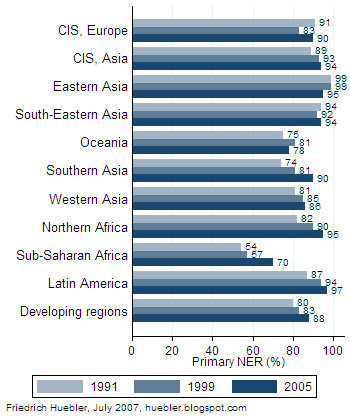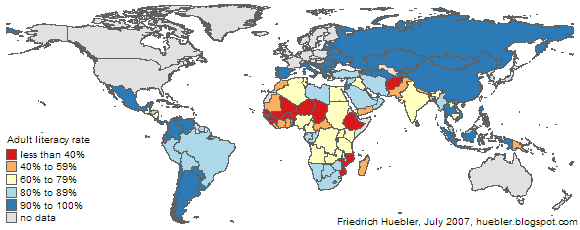Two recent articles on this web site present the latest data from the
UNESCO Institute for Statistics (UIS) on
adult literacy and
youth literacy worldwide. The adult literacy rate refers to the population aged 15 years and over, the youth literacy rate to the population aged 15 to 24 years. Youth literacy is generally higher than adult literacy, due to increasing levels of school attendance over the past decades.
The scatter plot in Figure 1 compares adult and youth literacy in 133 countries with data. The adult literacy rate is plotted along the horizontal axis and the youth literacy rate along the vertical axis. Almost all countries are located above the 45 degree line in the graph, which means that youth literacy is higher than adult literacy. Countries with no difference between the two literacy rates are located along the 45 degree line.
Figure 1: Adult and youth literacy: all countries with data
Source: UNESCO Institute for Statistics, Data Centre, June 2007.
Many countries are located close together in the upper right corner of Figure 1. To show the distribution in that part of the graph more clearly, Figure 2 plots only the 87 countries with literacy rates above 80 percent. Because of the scale, the difference between adult and youth literacy is exaggerated compared to Figure 1. The shape and color of the markers in both graphs indicate the
Millennium Development Goal (MDG) region in which each country is located. The lowest literacy rates, below 60 percent, are reported for countries in Sub-Saharan Africa and Southern Asia.
As Figure 2 shows, some countries from Sub-Saharan Africa and Southern Asia have highly literate populations, with literacy rates above 80 or 90 percent. Other countries with high literacy rates are located in Latin America and the Caribbean, Western Asia, South-eastern Asia, and the other MDG regions. Developed countries and countries from the Commonwealth of Independent States are clustered in the upper right corner of Figure 2, near 100 percent adult and youth literacy.
Figure 2: Adult and youth literacy: countries with literacy rates above 80 percent
Source: UNESCO Institute for Statistics, Data Centre, June 2007.
The average literacy rates in each MDG region are listed in Table 1. The mean literacy rates are simple unweighted averages across the countries with literacy data in a region and the values are therefore not representative for the entire population in each region.
Table 1 confirms the impression from Figure 1: adult and youth literacy rates are lowest in Sub-Saharan Africa and Southern Asia. In both regions, less than two thirds of the adult population are literate and the youth literacy rate is 10 to 12 percent higher than the adult literacy rate. In Western Asia, the youth literacy rate is also 10 percent above the adult literacy rate, but with an adult literacy rate of 85 percent, many more people can read and write than in Sub-Saharan Africa and Southern Asia.
The difference between the two literacy rates is greatest in Northern Africa, where 88 percent of the population aged 15 to 24 years are literate, compared to 70 percent of the population aged 15 years or more. Based on the available data, smaller gaps between adult and youth literacy exist in Eastern Asia, South-eastern Asia, Oceania, and Latin America and the Caribbean. In the developed countries and in the countries of the Commonwealth of Independent States, nearly the entire adult population is literate.
Table 1: Adult and youth literacy by MDG region| MDG region | Countries
with data in region | Adult literacy
rate (%) | Youth literacy
rate (%) | Difference youth-adult
literacy rate (%) |
| Developed countries | 16 | 97.1 | 99.1 | 2.1 |
| Commonwealth of Independent States | 10 | 99.2 | 99.8 | 0.6 |
| Eastern Asia | 3 | 93.3 | 98.7 | 5.4 |
| South-eastern Asia | 10 | 86.9 | 93.7 | 6.8 |
| Oceania | 4 | 82.2 | 88.4 | 3.5 |
| Southern Asia | 8 | 63.1 | 75.1 | 12.0 |
| Western Asia | 14 | 85.1 | 94.8 | 9.8 |
| Northern Africa | 5 | 70.4 | 87.6 | 17.2 |
| Sub-Saharan Africa | 42 | 61.5 | 71.1 | 10.3 |
| Latin America and the Caribbean | 25 | 89.1 | 94.8 | 5.3 |
| World | 137 | 79.4 | 87.0 | 7.5 |
Source: UNESCO Institute for Statistics, Data Centre, June 2007. Regional averages are unweighted. 137 countries have data on adult literacy, 133 countries have data on youth literacy.
Please visit the
UIS Data Centre to download complete tables with national data on adult and youth literacy.
Related articlesExternal linksFriedrich Huebler, 22 July 2007 (edited 17 October 2008), Creative Commons License
Permanent URL: http://huebler.blogspot.com/2007/07/disparity-between-adult-and-youth.html
 In June 2007, the United Nations published the latest edition of its annual report on progress toward the Millennium Development Goals (MDG). The Millennium Development Goals Report 2007 presents data for each of the eight MDGs.
In June 2007, the United Nations published the latest edition of its annual report on progress toward the Millennium Development Goals (MDG). The Millennium Development Goals Report 2007 presents data for each of the eight MDGs.











